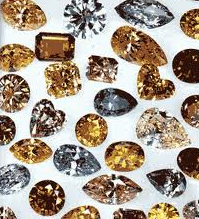Articles and News
CONCERNS GROW OVER INCREASE IN UNDISCLOSED TREATED MELEE | July 20, 2011 (4 comments)

Carlsbad, CA—The surge in popularity of colored diamonds has raised concerns that some designer jewelry with small fancy-color yellow, pink, or black melee may contain treated stones that are not disclosed as such at point of sale, according to GIA (Gemological Institute of America).
An article in the GIA Insider newsletter last week says grading labs historically have seen very few stones smaller than .20 ct. The cost of grading them, plus the sheer volume of them in the marketplace, has made it economically unfeasible to submit them for testing. But only one in 10,000 natural diamonds qualifies as a fancy—raising the likelihood that some of these stones are treated or synthetic.
Yellow melee, in particular, is likely to have undergone high-pressure, high-temperature (HPHT) treatment, says the article. Additionally, 90-95% of blacks are treated, so unless a retailer or manufacturer gets a written disclosure from the supplier that they are natural, assume they’re treated, says Rob May, executive director of the Natural Colored Diamond Association (NCDIA).
May acknowledged the article’s point that melee traditionally isn’t checked by the labs, though he believes most high-end suppliers and retailers generally do at least spot-check parcels, if not examine every stone.
But ignorance is not bliss, May told The Centurion. Retailers and designers need to ask for disclosure. NCDIA’s website has an entire section dedicated to disclosure, including Federal Trade Commission Guidelines, questions to ask of suppliers, and what to request be written on the invoice.
That said, he acknowledges there have been documented cases where a middleman bought a parcel of properly disclosed treated stones, then turned around and re-sold them as natural.
“You’re setting yourself up if you don’t ask [for disclosure],” he said. “You have to check the credentials of people you don’t know, and if a price seems too good to be true it probably is. If you call five dealers and four of them are selling a parcel of melee at $2,000-$2,500 per carat but one is selling it for $1,100, you should be suspect.” It’s not a good deal if it’s misrepresented, he said.
Knowing who you’re dealing with is important, says Todd Wolleman of New York-based Leo Wolleman, which sells colored diamonds—including irradiated melee—as well as colored gemstones. “We disclose everything,” he says firmly. Retail customers don’t need to ask, he says, since it’s always provided. “It’s Leo Wolleman’s reputation on the line.”
May encourages buying from NCDIA members, who are required to sign an annual pledge that they will disclose any treated or synthetic stones. (NCDIA members are permitted to sell non-natural colored diamonds as long as the majority of their business is done in natural colors and full disclosure accompanies the sale of any others.)
Retailers and designers who don’t ask for disclosure are not looking after their customers, May said. “Disclosure creates consumer confidence. Non-disclosure creates mayhem,” he told The Centurion.
GIA, meanwhile, is working on developing economic ways to grade small stones, says the Insider article. Read the complete article here.







